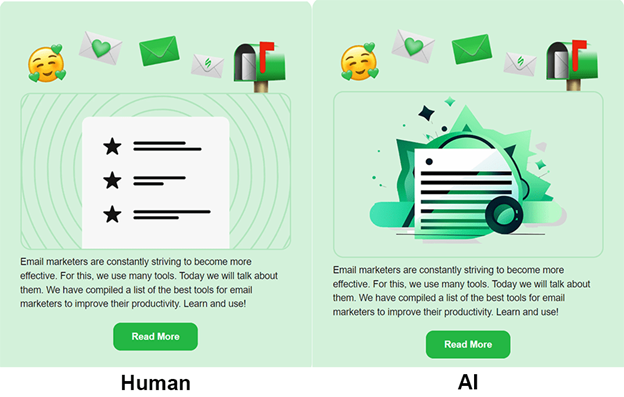Building email with generative AI: From fragments to whole campaigns
Generative AI today is quite a big trend that is rapidly gaining momentum and finding its place in the work processes of email marketers. Statistics confirm this, since:
- 43% of respondents rely heavily on GenAI in email creation processes
- 49% of email marketers believe GenAI helps them make their emails more personalized
- 95% of marketers rate the use of GenAI as effective
- 58.3% of marketers express confidence in GenAI’s potential to enhance email newsletters
However, there are more advanced applications of GenAI that email marketers can adopt. It’s time to reveal how generative AI can help marketers create emails and even whole email campaigns.
Application of generative AI and emails
GenAI is a constantly developing and evolving tool. Just a few years ago, it was difficult for marketers to find a use for it in email marketing. Today, GenAI helps perform useful tasks and saves time.
Working with text and images
Generating text is the first thing GenAI learned to do, and with this, it has excelled. Marketers can easily generate text for emails of any size and for any context, make text casual or formal, and much more. GenAI is also excellent at proofreading texts to eliminate typos, grammatical errors, and other mistakes that could be made in email text written by marketers. GenAI also allows marketers to create unified texts, which greatly affect email performance.

GenAI has been gradually learning storytelling, which is also a trend in email marketing. Now, GenAI texts can be used not only to sell or entice but also to tell stories.
Generating images is also one of GenAI’s strengths. Correctly written prompts allow one to generate any image that can later serve as an excellent draft for subsequent refinement by designers. At the moment, images created by GenAI have slightly lower performance than images created by designers. Therefore, the generated images need to have a human touch added to them.

We sent several emails to compare the effectiveness of images in them created by designers and GenAI and received the following results on average:
- AI CTOR: 19.3%
- Human CTOR: 23%
Data preparation
GenAI’s analytical capabilities also allow it to prepare data for future email campaigns and suggest strategies to improve them. It can analyze specific aspects of emails, how they correlate with existing statistics, and how they can be improved.
GenAI can also analyze current newsletters and match results and content. Based on this, it can give advice (or a whole checklist) on how to create better new emails or shed light on exactly which elements of emails attract the attention of subscribers. GenAI can analyze a new email and comment on what should be added where, considering best past newsletters and their content.
Ideation
Email campaigns involve a constant process for coming up with new ideas, and GenAI is also an indispensable assistant because it can generate themes for email campaigns, new approaches to design, interactions with the audience based on analysis, and much more. Creative blocks stop being so critical when a marketer has access to a convenient tool for generating ideas and raising the creative bar of email newsletters.
Generating email with GenAI: From basics to campaigns
Generating emails with GenAI is an evolving process with the expansion of AI capabilities and the development of what can be generated. The whole process can be divided into the following five stages:
Stage 1. Independent fragment
It all starts with independent tasks: generating subject lines and separating text for the email body—anything that saves time but is not part of something unified. Even though such tasks are isolated, in general, they save marketers time on routine.
This stage is the most basic, so the results that GenAI produces may be far from perfect or suitable. To make them better, context should be added to all queries (known as instructions), which will narrow down generative possibilities and guide GenAI down the right path.
Stage 2. Fragment as part of a whole
The second stage involves GenAI performing the same tasks as with fragments; however, they are now part of larger processes. Such tasks correspond to the overall strategy and must comply with certain rules. For example, GenAI can create texts with a certain tone of voice that corresponds to the company’s marketing rules and use terminology specific to a niche or brand.
As a result, at this stage, GenAI becomes not only a tool for creating content but also an effective helper in maintaining email integrity and quality. This is possible because the instructions from Stage 1 are already within GenAI; they can be used right away, providing the result needed.
Stage 3. Content module
From this stage on, GenAI can generate content in separate email blocks (or modules) in emails. An excellent example is our case: we generated unified text in separate modules in one email, which increased our CTOR by 41.34%.
The generated content comprises all previous content and is now organic in the context of a specific email. However, there’s always room for improvement, and to make workflow with GenAI even better and to widen its capabilities, data must be added.
Stage 4. Full-fledged email
This is what we are all here for—full-fledged email generation. Currently, GenAI can help create emails in the following ways:
- Creating an email brief for a marketer upon request
- Generating text for an entire email according to a prewritten plan
- Generating an email in the required format based on email purpose and type
- Automating an entire email creation process
All of the above require data, as GenAI produces content based on it. This is especially true of the automation of email generation. For example, to generate an email invitation to a webinar, data are needed that can be divided into several levels:
1. Basic data (e.g., title, date, webinar description)
2. Detailed information (e.g., speakers, reason for attending, platform, registration method)
3. Extended data (existing data scaled for all possible use cases: webinar date in different time zones, links to save the event in different calendars, etc.)
4. Supporting information (data that helps sell the webinar, e.g., social proof, detailed speaker descriptions, announcements of Q&A sessions, behind-the-scenes content, etc.)
5. Post-production information (promotion data after recording, e.g., various presentations, webinar recordings with highlights, Q&A follow-ups, etc.)
The more accurately generated content needs to be, the more data GenAI needs to work with.
Stage 5. The entire email campaign
Generating full-fledged email campaigns is currently the last stage of GenAI development, in which it creates entire email campaign strategies that marketers can apply. GenAI can generate for marketers a number of emails within each campaign, what is best to send and when, what content should be sent to which segment, etc. GenAI takes on the role of advisor on email campaign strategies. This requires data that must be “fed” to GenAI so that it can gradually learn, analyze, and make predictions and conclusions that will be part of its decision-making process.
Wrapping up
GenAI has the potential not only to become a key player on an email marketing team but also to radically transform it. By empowering marketing GenAI with the expertise, knowledge, and data it needs, we can open the door to a new era of efficient email marketing processes, in which it can generate content, advise strategies, help with ideation, and much more.
 Photo by Ashkan Forouzani on Unsplash
Photo by Ashkan Forouzani on Unsplash

 How to resolve AdBlock issue?
How to resolve AdBlock issue? 
 Founder and CEO of
Founder and CEO of